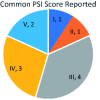Comparative efficacy of azithromycin versus clarithromycin in combination with beta-lactams to treat community-acquired pneumonia in hospitalized patients: a systematic review
- PMID: 34719987
- PMCID: PMC8645313
- DOI: 10.1177/03000605211049943
Comparative efficacy of azithromycin versus clarithromycin in combination with beta-lactams to treat community-acquired pneumonia in hospitalized patients: a systematic review
Abstract
Objective: The objective was to compare the efficacy of azithromycin and clarithromycin in combination with beta-lactams to treat community-acquired pneumonia among hospitalized adults.
Methods: Five databases (PubMed, Google Scholar, Trip, Medline, and Clinical Key) were searched to identify randomized clinical trials with patients exposed to azithromycin or clarithromycin in combination with a beta-lactam. All articles were critically reviewed for inclusion in accordance with the Preferred Reporting Items for Systematic Reviews and Meta-Analyses (PRISMA) guidelines.
Results: Seven clinical trials were included. The treatment success rate for azithromycin-beta-lactam after 10 to 14 days was 87.55% and that for clarithromycin-beta-lactam after 5 to 7 days of therapy was 75.42%. Streptococcus pneumoniae was commonly found in macrolide groups, with 130 and 80 isolates in the clarithromycin-based and azithromycin-based groups, respectively. The length of hospital stay was an average of 8.45 days for patients receiving a beta-lactam-azithromycin combination and 7.25 days with a beta-lactam-clarithromycin combination.
Conclusion: Macrolide inter-class differences were noted, with a higher clinical success rate for azithromycin-based combinations. However, a shorter length of hospital stay was achieved with a clarithromycin-beta-lactam regimen. Thus, a macrolide combined with a beta-lactam should be chosen using susceptibility data from the treating facility.
Keywords: Community-acquired pneumonia; Streptococcus pneumoniae; azithromycin; beta-lactam; clarithromycin; macrolide; meta-analysis; respiratory tract infection; susceptibility data.
Conflict of interest statement
Figures






Similar articles
-
Effectiveness of β-Lactam Monotherapy vs Macrolide Combination Therapy for Children Hospitalized With Pneumonia.JAMA Pediatr. 2017 Dec 1;171(12):1184-1191. doi: 10.1001/jamapediatrics.2017.3225. JAMA Pediatr. 2017. PMID: 29084336 Free PMC article.
-
Survival benefit associated with clarithromycin in severe community-acquired pneumonia: A matched comparator study.Int J Antimicrob Agents. 2020 Jan;55(1):105836. doi: 10.1016/j.ijantimicag.2019.10.017. Epub 2019 Nov 5. Int J Antimicrob Agents. 2020. PMID: 31704213
-
Comparative Efficacy of Beta-Lactams and Macrolides in the Treatment of Pediatric Pneumonia: A Systematic Review.Curr Pediatr Rev. 2020;16(4):307-313. doi: 10.2174/1573396316666200907115800. Curr Pediatr Rev. 2020. PMID: 32895041
-
Is azithromycin the first-choice macrolide for treatment of community-acquired pneumonia?Clin Infect Dis. 2003 May 15;36(10):1239-45. doi: 10.1086/374846. Epub 2003 May 6. Clin Infect Dis. 2003. PMID: 12746768 Clinical Trial.
-
Anti-inflammatory effects of macrolides--an underappreciated benefit in the treatment of community-acquired respiratory tract infections and chronic inflammatory pulmonary conditions?J Antimicrob Chemother. 2005 Jan;55(1):10-21. doi: 10.1093/jac/dkh519. Epub 2004 Dec 8. J Antimicrob Chemother. 2005. PMID: 15590715 Review.
Cited by
-
The Global Burden of Community-Acquired Pneumonia in Adults, Encompassing Invasive Pneumococcal Disease and the Prevalence of Its Associated Cardiovascular Events, with a Focus on Pneumolysin and Macrolide Antibiotics in Pathogenesis and Therapy.Int J Mol Sci. 2023 Jul 3;24(13):11038. doi: 10.3390/ijms241311038. Int J Mol Sci. 2023. PMID: 37446214 Free PMC article. Review.
-
Identifying the Best Initial Oral Antibiotics for Adults with Community-Acquired Pneumonia: A Network Meta-Analysis.J Gen Intern Med. 2024 May;39(7):1214-1226. doi: 10.1007/s11606-024-08674-1. Epub 2024 Feb 15. J Gen Intern Med. 2024. PMID: 38360961 Free PMC article.
-
Impact of Administering Intravenous Azithromycin within 7 Days of Hospitalization for Influenza Virus Pneumonia: A Propensity Score Analysis Using a Nationwide Administrative Database.Viruses. 2023 May 10;15(5):1142. doi: 10.3390/v15051142. Viruses. 2023. PMID: 37243228 Free PMC article.
-
Diagnostic and Prognostic Roles of Procalcitonin and Other Tools in Community-Acquired Pneumonia: A Narrative Review.Diagnostics (Basel). 2023 May 26;13(11):1869. doi: 10.3390/diagnostics13111869. Diagnostics (Basel). 2023. PMID: 37296721 Free PMC article. Review.
-
Appropriateness of antimicrobial selection for treatment of pneumonia in selected public hospitals of Eastern Ethiopia: A cross-sectional study.SAGE Open Med. 2023 Apr 13;11:20503121231163792. doi: 10.1177/20503121231163792. eCollection 2023. SAGE Open Med. 2023. PMID: 37065976 Free PMC article.
References
-
- WHO | Disease burden and mortality estimates [Internet]. WHO. World Health Organization; 2019. [cited 2021 Apr 25]. Available from: http: //www.who.int/healthinfo/global_burden_disease/estimates/en/
-
- Ramirez JA, Wiemken TL, Peyrani P, et al.. Adults hospitalized with pneumonia in the United States: incidence, epidemiology, and mortality. Clin Infect Dis 2017; 65: 1806–1812. Available from: https://pubmed.ncbi.nlm.nih.gov/29020164/ - PubMed
-
- ABCs 2018 Strep pneumoniae report | CDC [Internet]. [cited 2021 Apr 25]. Available from: https://www.cdc.gov/abcs/reports-findings/survreports/spneu18.html
-
- Ynthia W, Hitney CG, Onica F, Arley MM, Ames Adler JH, et al.. Increasing prevalence of multidrug-resistant Streptococcus pneumoniae in the United States. Vol. 343. 1917. DOI: 10.1056/NEJM200012283432603 - PubMed
Publication types
MeSH terms
Substances
LinkOut - more resources
Full Text Sources

